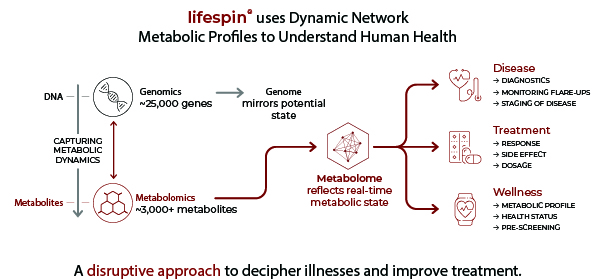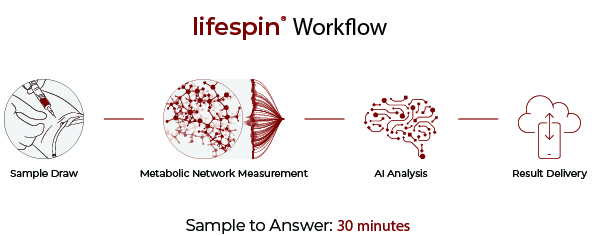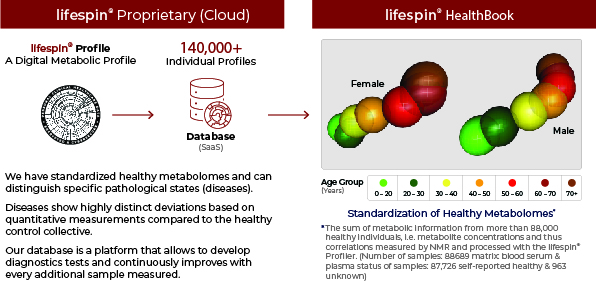Metabolomics, an emerging clinical modality, enabling precision, personalized medicine
Megatrends
Digital transformation is, without question, one of the most significant revolutionary trends in the history of mankind, comparable to the invention of the first wheel, Gutenberg’s printing press, or the Internet. We are now able to systematically digitize countless information and data that until relatively recently, needed to be stored and locked up in metal filing cabinets.
For the field of medicine, the digital revolution is transforming research, methods, procedures and treatment options, in fact almost everything that investigative scientists and clinicians do today. And one of the most profound is in the study and clinical application of the human metabolome. Utilizing digital technology, the medical industry now has the fundamental tools to literally build and quantify a complete metabolic health “atlas” of the human species, opening the way for clinicians to potentially make difficult diagnostics as easy as browsing through the web.
The past three decades have been dominated by the genomics and IT/Data Science revolution: Genomics was the aperture for a better understanding of biology and laid the foundation for precision medicine; IT/Data Science enabled massive analysis with advanced algorithms (e.g., machine learning, artificial intelligence) and new fast-scaling cloud-based business models accessible for everyone anywhere (e.g., Software-as-a-Service, SaaS). As this technological convergence of biology and Data Science has expanded, new and very powerful tools are emerging for healthcare.
One area in particular has proved very promising: namely, the use of the metabolome in early diagnostics – ideally before the onset of a disease – and with it personalized treatment options based on individual patient characteristics (e.g., genetic profile, phenotype, lifestyle). Combined, these new developments offer promise to dramatically improve treatment efficacy and the quality of life of patients, while also reducing the healthcare cost burden of societies.
The science of the metabolome
While genomics has emerged as a powerful tool to provide insights about the biological capability and genetic risk factors (e.g., as shown in cancer), the study of the metabolome offers the ability to provide more immediate insights into physiology and pathology of an individual. New metabolic-linked tools are now evolving that complement genomics and assist clinicians in gaining added and deeper insights even closer to the actual physiological state of an individual.
The human collection of metabolites provides many of these clues into a person’s health status. Metabolites are the chemical products of metabolism needed to do everything from moving, to thinking, to growing. They are necessary to power the myriads of chemical reactions that occur in living beings, for instance, to convert food into energy. The complete set of metabolites found within a biological sample is the metabolome.
Circulating metabolites feed bodily organs a continuous supply of essential nutrients and building blocks. Failure to maintain these circulating levels can cause disease.
Metabolomics is the analysis of the unique biochemical fingerprints of biological processes [1] and is directly correlated with the function-
ality of the organism, and therefore provides the closest indication of the state of an organism: healthy or sick. Clinical metabolomics for personalized medicine is probably the most promising application field [2]. Diseases distinctively impact metabolism causing specific changes in metabolic relationships, i.e., in the quantity of metabolites (Figure 1).
Technology
Lifespin is developing a highly scalable, proprietary technology platform for capturing and digitizing individual metabolomes: Hundreds of metabolite compounds and concentrations can be identified from a single human blood sample utilizing a Nuclear Magnetic Resonance (NMR) spectroscopy measurement [3].
Lifespin’s proprietary platform solution can use a range of patient samples such as blood (plasma or serum), urine, saliva, or cerebrospinal fluid without sample preparation and added into an NMR test tube (Figure 2).
Lifespin™Profiler software then enables the detection of about 1400 different metabolites. It allows processing of NMR metadata in a unique fashion to embrace a large dynamic concentration range. One important aspect of the Lifespin™Profiler algorithm is that it eliminates the intrinsic, individual measurement error for each individual metabolite. This allows a quantitative comparability of metabolites at different metabolic states and hence, a very precise capture of an individual’s metabolism. Mass spectrometry cannot deliver this level of quantitative, digital capture (“snapshot”) of meta-
bolomes. Hence, NMR enabled with Lifespin’s profiler technology is the only approach (to our knowledge) which allows comprehensive digitization of quantitative, metabolic information.
Using this proprietary method, we have standardized the baseline for human health with digital metabolic profiles of currently more than 140,000 healthy individuals allowing analysis of more than 1 billion metabolic relationship data points. Highly sophisticated data science algorithms are continuously searching for disease-specific signatures in the metabolic data. Our database is constantly growing, both with regards to patient samples representing various fields of disease as well as gender and age-specific changes (Figure 3).
We can detect distinct deviations caused by diseases and read them as disease-specific metabolic signatures. Digital metabolic profiles will enable the early detection of health conditions, staging of disease, monitoring treatment success, and personalized medicine.
Our platform technology has the potential to address technically all diseases which are linked to metabolism. Currently we have ongoing collaborations and clinical studies in the fields of oncology (incl. diagnosis of breast, rectal, pancreatic cancer and tumour profiling), neurological diseases such as multiple sclerosis and Parkinson’s, and inflammatory diseases like arthritis. We are in the process of identifying disease-specific metabolic signatures which can be used for early diagnostics. For example, we have identified very promising metabolic fingerprints specific for various types of cancer. A general cancer screening tool and an organ-specific multiplex cancer diagnostic test accessible as a SaaS product is a very concrete example of our evolving product portfolio.
Another advanced case is our early detection of the beginning of Multiple Sclerosis (MS). MS is a disease which is very hard to diagnose because of the absence of a specific biomarker in traditional in vitro diagnostics (IVD). Current standard-of-care for the diagnostics of MS is a tedious and costly series of different types of tests. In the absence of legacy IVD solutions, we are developing our own proprietary algorithm for the diagnosis of MS based on unique metabolite signatures and are expecting early deployment with select laboratory partners in the next 9-12 months.
Our methods translate assay development into the digital world and make diagnostic product development as simple as coding new apps for a smartphone: Lifespin does not require chemical reagents for the development of e.g., IVD tests. As the product is an IVD-as-software, no cold-chain logistics is required to transport assays to customers. The NMR-measurement can be performed anywhere, the read-out, testing and communication of test results are fully digital and will be cloud-based. The NMR equipment “just” functions as a smart spectroscope enabled with our software.
Benefits for patients and providers
The Lifespin solutions, and other advances in the study and commercialization of the metabolome can be used to the benefit of patients as well as healthy individuals. At Lifespin, we are assessing metabolic profiles, which are dynamic networks, to understand human health. Our platform will allow early disease diagnostics as well as monitoring of flare-ups and staging of diseases. Insights to improve treatment by monitoring response to drugs and side effects will improve individual dosage of medication. Healthy individuals will be enabled to assess their health status and unlock health insights to improve lifestyle and well-being.
In a real-world scenario, the patent sample (e.g., blood plasma) would be directly – without any sample preparation steps – measured by NMR. Within a few minutes the patient’s metabolome is being digitized and processed with the Lifespin™Profiler to assess the individual’s general health status. Pathological metabolite signatures will trigger the diagnostics (IVD-as-Software) functionality of the profiler. We are currently developing a prototype which will allow as the first step a general cancer screening and as a second step the diagnostics of the organ-specific type of cancer (e.g., breast, rectal, pancreas). Moving forward the Lifespin™Profiler will be also used to assess the growth of tumours and treatment response. This functionality will be particularly important for determination of tumour phenotypes. Another real-world example would be the longitudinal monitoring of high-risk individuals for metabolic conditions. A periodic monitoring of, for example, inflammation signatures would prevent worsening of conditions and help determine the right countermeasures (e.g., change of diet). Ultimately our tool could also be used to provide guidance to individuals for example, in the context of healthy ageing by providing longitudinal metabolic information which is the most direct way to learn about actual well-being and health status.
Outlook
Lifespin continues to systematically digitize the human metabolome with the goal of building a comprehensive metabolic health atlas. Our vision is to make personal health status information available at an individual’s fingertip for use in preventative and direct-to-consumer healthcare for healthy individuals – as well as in diagnostics and treatment monitoring for patients and providers.
Fig. 1: Metabolic profiles are dynamic networks that we use to understand human health.
Fig. 2: The metabolic status of an individual is measured quantitatively with NMR and processed with Lifespin™ proprietary advanced artificial intelligence (AI) and deep learning algorithms for the determination of health status and diagnosis of diseases and results are delivered via the cloud.
Fig. 3: We standardized the healthy metabolome, which shifts with age, for both sexes. This serves as a unique reference to compare metabolomes of diseased patients against. Study performed at Lifespin 2020-2021.
About Lifespin
Lifespin (www.lifespin.ai ) is a deep data company that maps human health based on metabolomics. Lifespin has standardized the baseline for human health to detect distinct deviations in the human metabolome caused by diseases. Studies show that pathogenesis impacts metabolism, causing specific changes in the presence and quantity of metabolites. Lifespin is building an in-house biobank that already consists of more than 200,000 human blood samples. Lifespin’s proprietary diagnostic technology platform is able to quantitatively capture individual metabolomes, i.e., up to hundreds of metabolite concentrations with a single Nuclear Magnetic Resonance (NMR) measurement. Utilizing its technology, Lifespin is performing quantitative in-house measurements of metabolomes for systematic mapping across various health conditions, digitizing metabolic profiles that include billions of metabolic relationships. These digital metabolic profiles will enable differential diagnosis for the early detection of health conditions, staging of diseases, monitoring of treatment success and personalized medicine. Lifespin’s first regulatory approved Software-as-IVD will be for the early differential diagnosis of Multiple Sclerosis and is expected in Europe in 2022, and thereafter in the United States. Additional tests for the detection of neurological, cancer, and inflammatory diseases are in the pipeline. Lifespin’s cloud-based business model is built on its proprietary Software-as-a-Service (SaaS) platform for diagnostics and health information and is globally scalable. Lifespin’s advisory board consists of key opinion leaders such as James Rothman (Nobel Laureate in Physiology/Medicine, Sterling Professor of Cell Biology, Yale University, New Haven, CT USA) and other prominent leaders in the relevant fields of study.
Disclaimer
Lifespin’s products are for Research Use Only (RUO) and currently are not for use in diagnostic procedures. Lifespin Products have not been evaluated or approved by the FDA or any other regulatory authority. None of these statements have been endorsed by the FDA or any other regulatory authority. None of the products discussed in this material are currently being sold or offered for sale.
References
- Predicting human health from biofluid-based metabolomics using machine learning (Scientific Reports, Vol. 10, 17635, 2020);
The Project Baseline Health Study: a step towards a broader mission to map human health (npj Digital Medicine, Vol. 3, 84, 2020); - Metabolomics: An emerging potential approach to decipher critical illnesses (Biophysical Chemistry, Vol. 267, 106462, 2020);
A metabolic profile of all-cause mortality risk identified in an observational study of 44,168 individuals (Nature Communications, Volume
10, 3346, 2019); Metabolomics enables precision medicine: “A White Paper, Community Perspective” (Metabolomics, Vol. 12, 149, 2016) - Metabolites are measured with NMR spectroscopy. NMR sensitivity is lower (micromolar) compared to mass spectrometry (nanomolar);
however, it is quantitative, has a higher reproducibility with very short sample preparation time and without destroying the sample.
NMR enables fast measurement, where all metabolites at a detectable concentration level can be recorded in one measurement.
Mass spectrometry requires different ionization methods to maximize the number of detected metabolites.




